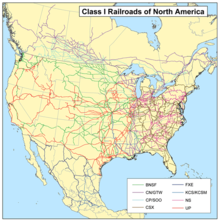Classification of American railways
The classification of the railways in North America is based on their turnover and serves as the basis for the preparation of statistics, reports, accounting obligations, legal and labor regulations.
The largest freight railways in the USA and Canada are designated as Class 1 . Smaller railways were designated as Class 2 or Class 3 . Today the Association of American Railroads uses the classification into regional railroads and local railroads .
history
The first classification of railway companies in different categories took place with the establishment of the Interstate Commerce Commission (ICC) in 1887. For the preparation of their annual report the railway companies were in the categories Class 1 (more than 1000 miles route network), Class 2 (600 to 1000 miles route network ), Class 3 (400 to 600 miles network), Class 4 (250 to 400 miles network) and Class 5 (less than 250 miles network). This division was used until 1910. As a result of the Hepburn Act and the associated expansion of the ICC's tasks, a new classification was introduced from 1911. Class 1 companies included companies with sales in excess of $ 1 million, Class 2 companies had sales between $ 100,000 and $ 1,000,000, and Class 3 companies had sales less than $ 100,000. Pure shunting companies were not included in this classification.
In 1956, the limit for a Class 1 company was raised to $ 3 million. At the same time, the Class 2 and Class 3 companies were combined into a Class 2. From this point on, the shunting companies were no longer included in the annual statistics and reports.
From 1976, a Class 1 railroad company had to have at least 10 million in sales. Another change took place in 1978. The limit for Class 1 has been raised to $ 50 million. At the same time, Class 2 ($ 10–50 million) and Class 3 (less than $ 10 million) were reintroduced. From 1982 the limits were adjusted according to the annual inflation. However, as early as 1979, the reporting requirements for class 2 and class 3 companies were waived. Thus, these limits have no practical effect.
Another change took place in 1992; now sales for a class 1 company have been set at $ 250 million and for class 2 companies at $ 20 million. Since then, there has been an annual adjustment in line with changes in transport prices in the rail sector ( Railroad Freight Rate Index ).
Since the classification into Class 2 and Class 3 no longer has any effect, the Association of American Railroads introduced three categories for classification in 1986.
- Regional railroads - more than 350 miles of route network and more than 40 million US dollars in revenue.
- Local railroads (formerly shortline railroads ) - local railways, but with scheduled route service.
- Switching and terminal railroads - railways that do not carry out point-to-point transports ( regular services ), but rather establish the connection between end customers and the other railway companies.
In Canada, as of 2004, Class 1 companies must have gross revenues of C $ 250 million each for the last two fiscal years.
|
|
Effect of classification
The setting of this limit is a political decision, because due to the different classification, different regulations and reporting requirements also apply to the companies. In 1991, for example, Montana Rail Link and Wisconsin Central asked to raise the limit to $ 93.5 million so that these companies could save additional costs. In late 1992, the limit was raised to $ 250 million, which resulted in the Florida East Coast Railway becoming just a Class 2 company.
There are currently seven Class 1 companies in the United States. East of the Mississippi these are CSX Transportation and the Norfolk Southern Railway , west of the Mississippi the BNSF Railway and the Union Pacific Railroad and in the midwest to Mexico the Kansas City Southern Railway . These include the Grand Trunk Corporation , a subsidiary of the Canadian National Railway , and the Soo Line Railroad , a subsidiary of the Canadian Pacific Railway .
The two Canadian Class 1 companies, Canadian National Railway and Canadian Pacific Railway, are also Class 1 companies under US rules. Applied to the Mexican railway companies, the Ferrocarril Méxicano and Kansas City Southern de México meet the requirements.
Amtrak and VIA Rail as passenger transport companies in the United States and Canada are not classified.
By the mid-1980s, all Class 1 companies together owned 94 to 96 percent of the total rail network in the United States and were responsible for 96 to 99 percent of rail sales. As a result of the change in the classification limits and the transfer of many routes to smaller railway companies, the Class 1 companies today achieve a turnover of around 93% of the rail industry on around 67% of the route network.
literature
- William D. Middleton : Classification . In: William D. Middleton, George M. Smerk, Roberta L. Diehl (Eds.): Encyclopedia of North American Railroads . Indiana University Press, Bloomington, IN 2007, ISBN 978-0-253-34916-3 , pp. 278-279 .
